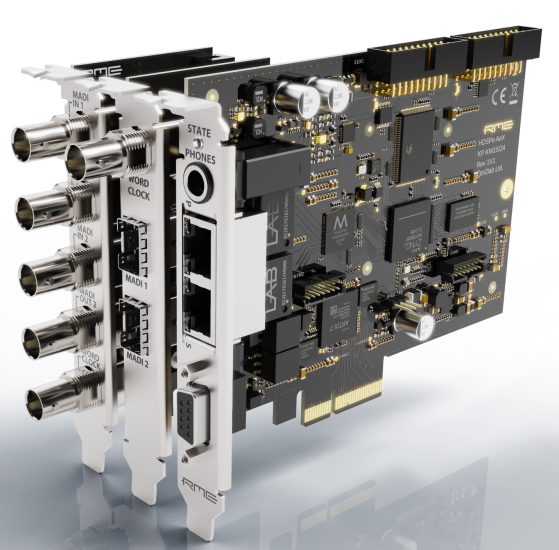RME HDSPe AoX Cards

The new HDSPe AoX cards once again set the reference for high performance audio interfaces. Available as a Dante version with 512 x 512 channels and as a Milan version with 128 x 128 channels, these cards leverage RME’s renowned driver architecture to bring high channel counts to any DAW – along with a 256-channel TotalMix engine, RME’s FPGA-based super low latency hardware mixer.
Occupying only a single slot, the PCIe x4 interface transmits and receives up to 512 channels of network audio signals on two separate gigabit Ethernet ports. The network audio channels can partially be replaced (or extended in case of the Milan version) with MADI signals by adding up to two optional dual optical SFP or dual coaxial extension cards. It is therefore possible to integrate four MADI input signals, four MADI output signals plus up to 256 network audio channels per direction within a single audio interface for the first time – on macOS and Windows.
In comparison to these massive channel counts, the ¼” stereo headphone jack occupies a lot of space on the card – and for good reason, because it allows engineers to monitor any signal reaching the card: from the computer, the network, or the optional MADI inputs. And to add one more signal to the mix – a stereo AES3 digital I/O is available together with MIDI on a breakout cable, making it a versatile and full-fledged professional interface. A word clock input/output port is available on the MADI option cards.
The vast number of channels can be managed by the user via the driver’s software dialog, which includes a routing matrix that creates the connections between hardware I/O and software I/O, offering a lot of flexibility. First, the user selects which 256 channels to send to TotalMix, which provides powerful features such as level metering, preset management, layouts, sub-mixes, loopback and more. An additional 256 channels can be selected by the user to be passed straight through to the DAW, meaning a total of 512 channels are visible for recording. Then, the user selects which channels – again 256 from TotalMix and an additional 256 channels straight from the DAW – should be sent to the card’s hardware outputs.
Higher sampling rates are supported with corresponding reduction of channel count: half at 96 kHz, a quarter at 192 kHz, except for the Milan version that supports 128 channels at 96 kHz and 64 channels at 192 kHz. Both cards can also be installed in external Thunderbolt enclosures as a perfect addition to mobile recording setups, or installed in common DAWs or audio processors.
 How to resolve AdBlock issue?
How to resolve AdBlock issue?